G2D图像处理硬件调用和测试-基于门徒娱乐全志T113-i开发板

2024-04-09

2072

来源:门徒娱乐电子
本篇测评由电子工程世界的优秀测评者“jf_99374259”提供。
本文将介绍基于门徒娱乐电子MYD-YT113i开发板的G2D图像处理硬件调用和测试。
MYC-YT113i核心板及开发板
真正的国产核心板,100%国产物料认证
国产T113-i处理器配备2*Cortex-A7@1.2GHz ,RISC-V
外置DDR3接口、支持视频编解码器、HiFi4 DSP
接口丰富:视频采集接口、显示器接口、USB2.0 接口、CAN 接口、千兆以太网接口
工业级:-40℃~+85℃、尺寸37mm*39mm
邮票孔+LGA,140+50PIN
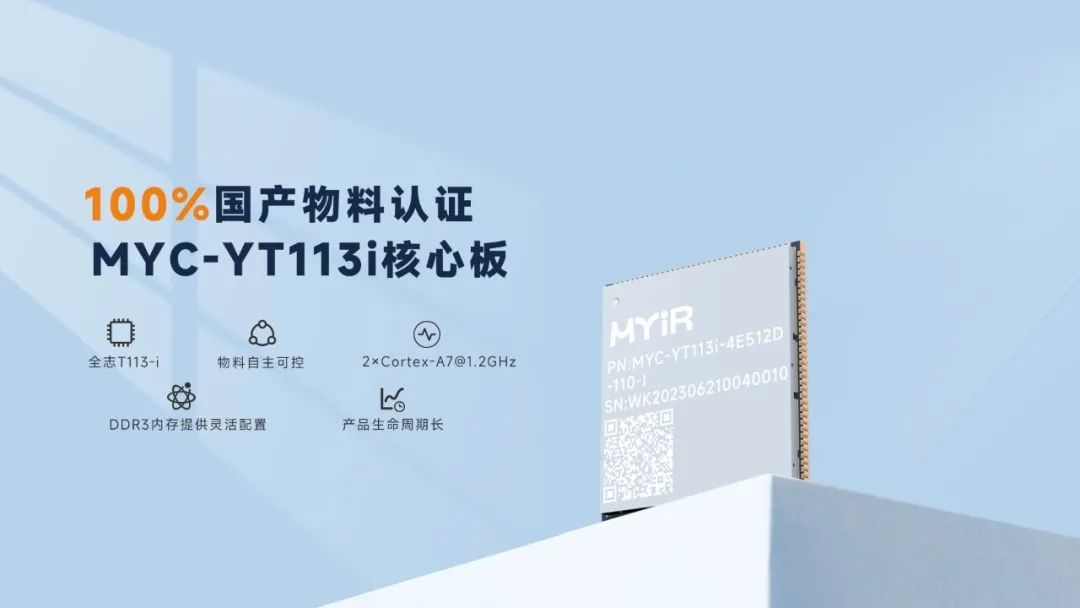
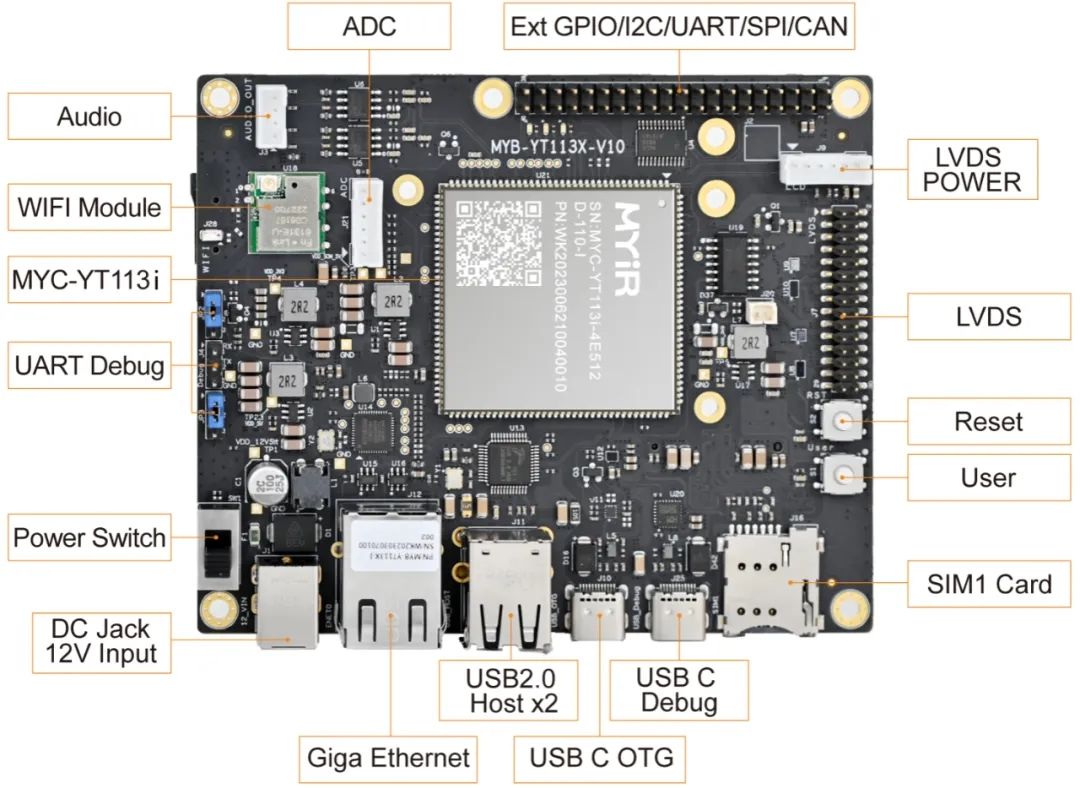
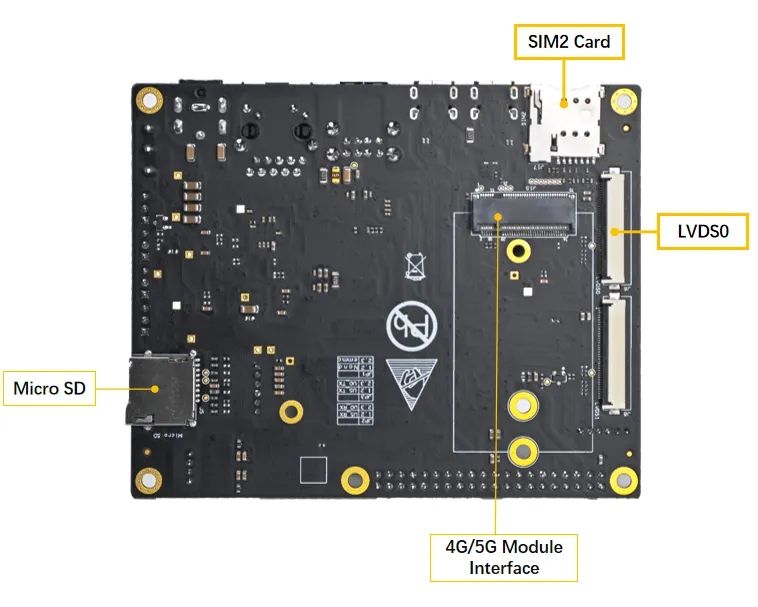
全志 T113-i 2D图形加速硬件支持情况
Supports layer size up to 2048 x 2048 pixels
Supports pre-multiply alpha image data
Supports color key
Supports two pipes Porter-Duff alpha blending
Supports multiple video formats 4:2:0, 4:2:2, 4:1:1 and multiple pixel formats (8/16/24/32 bits graphics
layer)Supports memory scan order option
Supports any format convert function
Supports 1/16× to 32× resize ratio
Supports 32-phase 8-tap horizontal anti-alias filter and 32-phase 4-tap vertical anti-alias filter
Supports window clip
Supports FillRectangle, BitBlit, StretchBlit and MaskBlit
Supports horizontal and vertical flip, clockwise 0/90/180/270 degree rotate for normal buffer
Supports horizontal flip, clockwise 0/90/270 degree rotate for LBC buffer
可以看到 g2d 硬件支持相当多的2D图像处理,包括颜色空间转换,分辨率缩放,图层叠加,旋转等
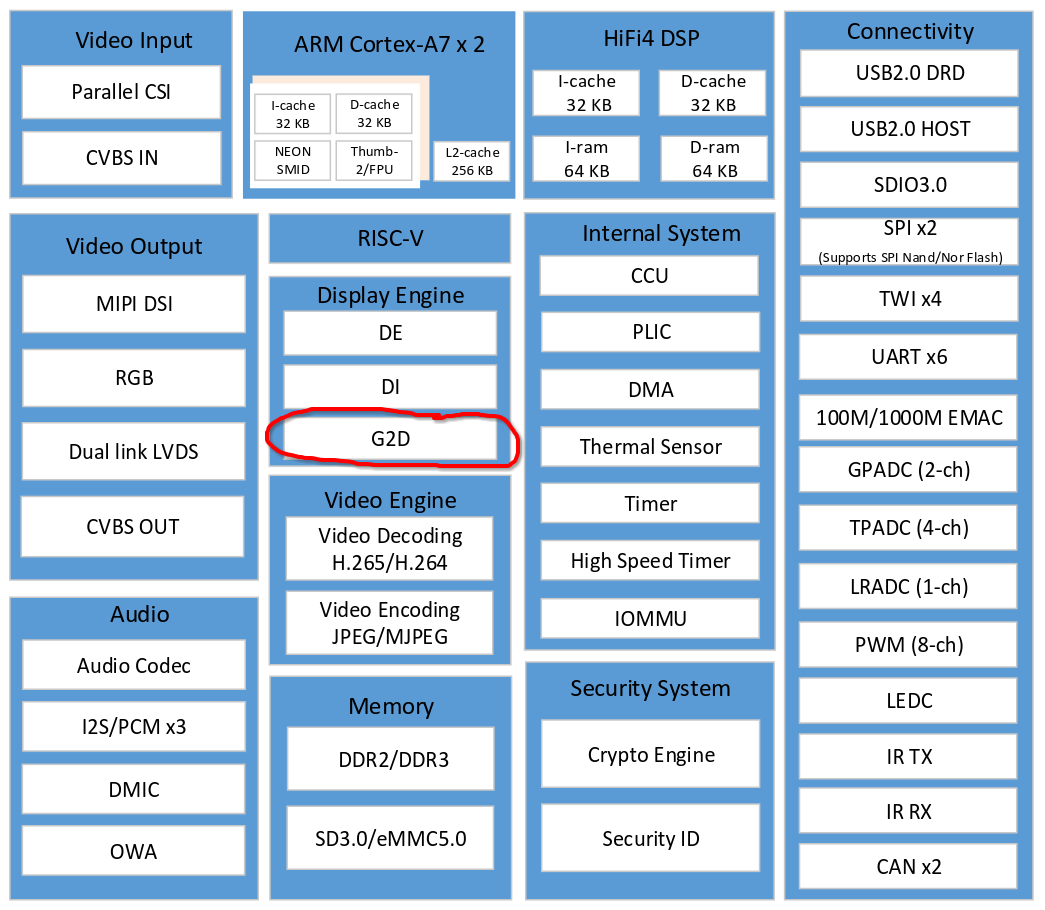
开发环境配置
基于C语言实现的YUV转RGB
这里复用之前T113-i JPG解码的函数
void yuv420sp2rgb(const unsigned char* yuv420sp, int w, int h, unsigned char* rgb)
{
const unsigned char* yptr = yuv420sp;
const unsigned char* vuptr = yuv420sp + w * h;
for (int y = 0; y < h; y += 2)
{
const unsigned char* yptr0 = yptr;
const unsigned char* yptr1 = yptr + w;
unsigned char* rgb0 = rgb;
unsigned char* rgb1 = rgb + w * 3;
int remain = w;
#define SATURATE_CAST_UCHAR(X) (unsigned char)::std::min(::std::max((int)(X), 0), 255);
for (; remain > 0; remain -= 2)
{
// R = 1.164 * yy + 1.596 * vv
// G = 1.164 * yy - 0.813 * vv - 0.391 * uu
// B = 1.164 * yy + 2.018 * uu
// R = Y + (1.370705 * (V-128))
// G = Y - (0.698001 * (V-128)) - (0.337633 * (U-128))
// B = Y + (1.732446 * (U-128))
// R = ((Y << 6) + 87.72512 * (V-128)) >> 6
// G = ((Y << 6) - 44.672064 * (V-128) - 21.608512 * (U-128)) >> 6
// B = ((Y << 6) + 110.876544 * (U-128)) >> 6
// R = ((Y << 6) + 90 * (V-128)) >> 6
// G = ((Y << 6) - 46 * (V-128) - 22 * (U-128)) >> 6
// B = ((Y << 6) + 113 * (U-128)) >> 6
// R = (yy + 90 * vv) >> 6
// G = (yy - 46 * vv - 22 * uu) >> 6
// B = (yy + 113 * uu) >> 6
int v = vuptr[0] - 128;
int u = vuptr[1] - 128;
int ruv = 90 * v;
int guv = -46 * v + -22 * u;
int buv = 113 * u;
int y00 = yptr0[0] << 6;
rgb0[0] = SATURATE_CAST_UCHAR((y00 + ruv) >> 6);
rgb0[1] = SATURATE_CAST_UCHAR((y00 + guv) >> 6);
rgb0[2] = SATURATE_CAST_UCHAR((y00 + buv) >> 6);
int y01 = yptr0[1] << 6;
rgb0[3] = SATURATE_CAST_UCHAR((y01 + ruv) >> 6);
rgb0[4] = SATURATE_CAST_UCHAR((y01 + guv) >> 6);
rgb0[5] = SATURATE_CAST_UCHAR((y01 + buv) >> 6);
int y10 = yptr1[0] << 6;
rgb1[0] = SATURATE_CAST_UCHAR((y10 + ruv) >> 6);
rgb1[1] = SATURATE_CAST_UCHAR((y10 + guv) >> 6);
rgb1[2] = SATURATE_CAST_UCHAR((y10 + buv) >> 6);
int y11 = yptr1[1] << 6;
rgb1[3] = SATURATE_CAST_UCHAR((y11 + ruv) >> 6);
rgb1[4] = SATURATE_CAST_UCHAR((y11 + guv) >> 6);
rgb1[5] = SATURATE_CAST_UCHAR((y11 + buv) >> 6);
yptr0 += 2;
yptr1 += 2;
vuptr += 2;
rgb0 += 6;
rgb1 += 6;
}
#undef SATURATE_CAST_UCHAR
yptr += 2 * w;
rgb += 2 * 3 * w;
}
}
基于ARM neon指令集优化的YUV转RGB
考虑到armv7编译器的自动neon优化能力较差,这里针对性的编写 arm neon inline assembly 实现YUV2RGB内核部分,达到最优化的性能,榨干cpu性能
void yuv420sp2rgb_neon(const unsigned char* yuv420sp, int w, int h, unsigned char* rgb)
{
const unsigned char* yptr = yuv420sp;
const unsigned char* vuptr = yuv420sp + w * h;
#if __ARM_NEON
uint8x8_t _v128 = vdup_n_u8(128);
int8x8_t _v90 = vdup_n_s8(90);
int8x8_t _v46 = vdup_n_s8(46);
int8x8_t _v22 = vdup_n_s8(22);
int8x8_t _v113 = vdup_n_s8(113);
#endif // __ARM_NEON
for (int y = 0; y < h; y += 2)
{
const unsigned char* yptr0 = yptr;
const unsigned char* yptr1 = yptr + w;
unsigned char* rgb0 = rgb;
unsigned char* rgb1 = rgb + w * 3;
#if __ARM_NEON
int nn = w >> 3;
int remain = w - (nn << 3);
#else
int remain = w;
#endif // __ARM_NEON
#if __ARM_NEON
#if __aarch64__
for (; nn > 0; nn--)
{
int16x8_t _yy0 = vreinterpretq_s16_u16(vshll_n_u8(vld1_u8(yptr0), 6));
int16x8_t _yy1 = vreinterpretq_s16_u16(vshll_n_u8(vld1_u8(yptr1), 6));
int8x8_t _vvuu = vreinterpret_s8_u8(vsub_u8(vld1_u8(vuptr), _v128));
int8x8x2_t _vvvvuuuu = vtrn_s8(_vvuu, _vvuu);
int8x8_t _vv = _vvvvuuuu.val[0];
int8x8_t _uu = _vvvvuuuu.val[1];
int16x8_t _r0 = vmlal_s8(_yy0, _vv, _v90);
int16x8_t _g0 = vmlsl_s8(_yy0, _vv, _v46);
_g0 = vmlsl_s8(_g0, _uu, _v22);
int16x8_t _b0 = vmlal_s8(_yy0, _uu, _v113);
int16x8_t _r1 = vmlal_s8(_yy1, _vv, _v90);
int16x8_t _g1 = vmlsl_s8(_yy1, _vv, _v46);
_g1 = vmlsl_s8(_g1, _uu, _v22);
int16x8_t _b1 = vmlal_s8(_yy1, _uu, _v113);
uint8x8x3_t _rgb0;
_rgb0.val[0] = vqshrun_n_s16(_r0, 6);
_rgb0.val[1] = vqshrun_n_s16(_g0, 6);
_rgb0.val[2] = vqshrun_n_s16(_b0, 6);
uint8x8x3_t _rgb1;
_rgb1.val[0] = vqshrun_n_s16(_r1, 6);
_rgb1.val[1] = vqshrun_n_s16(_g1, 6);
_rgb1.val[2] = vqshrun_n_s16(_b1, 6);
vst3_u8(rgb0, _rgb0);
vst3_u8(rgb1, _rgb1);
yptr0 += 8;
yptr1 += 8;
vuptr += 8;
rgb0 += 24;
rgb1 += 24;
}
#else
if (nn > 0)
{
asm volatile(
"0: n"
"pld [%3, #128] n"
"vld1.u8 {d2}, [%3]! n"
"vsub.s8 d2, d2, %12 n"
"pld [%1, #128] n"
"vld1.u8 {d0}, [%1]! n"
"pld [%2, #128] n"
"vld1.u8 {d1}, [%2]! n"
"vshll.u8 q2, d0, #6 n"
"vorr d3, d2, d2 n"
"vshll.u8 q3, d1, #6 n"
"vorr q9, q2, q2 n"
"vtrn.s8 d2, d3 n"
"vorr q11, q3, q3 n"
"vmlsl.s8 q9, d2, %14 n"
"vorr q8, q2, q2 n"
"vmlsl.s8 q11, d2, %14 n"
"vorr q10, q3, q3 n"
"vmlal.s8 q8, d2, %13 n"
"vmlal.s8 q2, d3, %16 n"
"vmlal.s8 q10, d2, %13 n"
"vmlsl.s8 q9, d3, %15 n"
"vmlal.s8 q3, d3, %16 n"
"vmlsl.s8 q11, d3, %15 n"
"vqshrun.s16 d24, q8, #6 n"
"vqshrun.s16 d26, q2, #6 n"
"vqshrun.s16 d4, q10, #6 n"
"vqshrun.s16 d25, q9, #6 n"
"vqshrun.s16 d6, q3, #6 n"
"vqshrun.s16 d5, q11, #6 n"
"subs %0, #1 n"
"vst3.u8 {d24-d26}, [%4]! n"
"vst3.u8 {d4-d6}, [%5]! n"
"bne 0b n"
: "=r"(nn), // %0
"=r"(yptr0), // %1
"=r"(yptr1), // %2
"=r"(vuptr), // %3
"=r"(rgb0), // %4
"=r"(rgb1) // %5
: "0"(nn),
"1"(yptr0),
"2"(yptr1),
"3"(vuptr),
"4"(rgb0),
"5"(rgb1),
"w"(_v128), // %12
"w"(_v90), // %13
"w"(_v46), // %14
"w"(_v22), // %15
"w"(_v113) // %16
: "cc", "memory", "q0", "q1", "q2", "q3", "q8", "q9", "q10", "q11", "q12", "d26");
}
#endif // __aarch64__
#endif // __ARM_NEON
#define SATURATE_CAST_UCHAR(X) (unsigned char)::std::min(::std::max((int)(X), 0), 255);
for (; remain > 0; remain -= 2)
{
// R = 1.164 * yy + 1.596 * vv
// G = 1.164 * yy - 0.813 * vv - 0.391 * uu
// B = 1.164 * yy + 2.018 * uu
// R = Y + (1.370705 * (V-128))
// G = Y - (0.698001 * (V-128)) - (0.337633 * (U-128))
// B = Y + (1.732446 * (U-128))
// R = ((Y << 6) + 87.72512 * (V-128)) >> 6
// G = ((Y << 6) - 44.672064 * (V-128) - 21.608512 * (U-128)) >> 6
// B = ((Y << 6) + 110.876544 * (U-128)) >> 6
// R = ((Y << 6) + 90 * (V-128)) >> 6
// G = ((Y << 6) - 46 * (V-128) - 22 * (U-128)) >> 6
// B = ((Y << 6) + 113 * (U-128)) >> 6
// R = (yy + 90 * vv) >> 6
// G = (yy - 46 * vv - 22 * uu) >> 6
// B = (yy + 113 * uu) >> 6
int v = vuptr[0] - 128;
int u = vuptr[1] - 128;
int ruv = 90 * v;
int guv = -46 * v + -22 * u;
int buv = 113 * u;
int y00 = yptr0[0] << 6;
rgb0[0] = SATURATE_CAST_UCHAR((y00 + ruv) >> 6);
rgb0[1] = SATURATE_CAST_UCHAR((y00 + guv) >> 6);
rgb0[2] = SATURATE_CAST_UCHAR((y00 + buv) >> 6);
int y01 = yptr0[1] << 6;
rgb0[3] = SATURATE_CAST_UCHAR((y01 + ruv) >> 6);
rgb0[4] = SATURATE_CAST_UCHAR((y01 + guv) >> 6);
rgb0[5] = SATURATE_CAST_UCHAR((y01 + buv) >> 6);
int y10 = yptr1[0] << 6;
rgb1[0] = SATURATE_CAST_UCHAR((y10 + ruv) >> 6);
rgb1[1] = SATURATE_CAST_UCHAR((y10 + guv) >> 6);
rgb1[2] = SATURATE_CAST_UCHAR((y10 + buv) >> 6);
int y11 = yptr1[1] << 6;
rgb1[3] = SATURATE_CAST_UCHAR((y11 + ruv) >> 6);
rgb1[4] = SATURATE_CAST_UCHAR((y11 + guv) >> 6);
rgb1[5] = SATURATE_CAST_UCHAR((y11 + buv) >> 6);
yptr0 += 2;
yptr1 += 2;
vuptr += 2;
rgb0 += 6;
rgb1 += 6;
}
#undef SATURATE_CAST_UCHAR
yptr += 2 * w;
rgb += 2 * 3 * w;
}
}
基于G2D图形硬件的YUV转RGB
我们先实现 dmaion buffer 管理器,参考
这里贴的代码省略了异常错误处理的逻辑,有个坑是 linux-4.9 和 linux-5.4 用法不一样,门徒娱乐电子的这个T113-i系统是linux-5.4,所以不兼容4.9内核的ioctl用法习惯
struct ion_memory
{
size_t size;
int fd;
void* virt_addr;
unsigned int phy_addr;
};
class ion_allocator
{
public:
ion_allocator();
~ion_allocator();
int open();
void close();
int alloc(size_t size, struct ion_memory* mem);
int free(struct ion_memory* mem);
int flush(struct ion_memory* mem);
public:
int ion_fd;
int cedar_fd;
};
ion_allocator::ion_allocator()
{
ion_fd = -1;
cedar_fd = -1;
}
ion_allocator::~ion_allocator()
{
close();
}
int ion_allocator::open()
{
close();
ion_fd = ::open("/dev/ion", O_RDWR);
cedar_fd = ::open("/dev/cedar_dev", O_RDONLY);
ioctl(cedar_fd, IOCTL_ENGINE_REQ, 0);
return 0;
}
void ion_allocator::close()
{
if (cedar_fd != -1)
{
ioctl(cedar_fd, IOCTL_ENGINE_REL, 0);
::close(cedar_fd);
cedar_fd = -1;
}
if (ion_fd != -1)
{
::close(ion_fd);
ion_fd = -1;
}
}
int ion_allocator::alloc(size_t size, struct ion_memory* mem)
{
struct aw_ion_new_alloc_data alloc_data;
alloc_data.len = size;
alloc_data.heap_id_mask = AW_ION_SYSTEM_HEAP_MASK;
alloc_data.flags = AW_ION_CACHED_FLAG | AW_ION_CACHED_NEEDS_SYNC_FLAG;
alloc_data.fd = 0;
alloc_data.unused = 0;
ioctl(ion_fd, AW_ION_IOC_NEW_ALLOC, &alloc_data);
void* virt_addr = mmap(NULL, size, PROT_READ|PROT_WRITE, MAP_SHARED, alloc_data.fd, 0);
struct aw_user_iommu_param iommu_param;
iommu_param.fd = alloc_data.fd;
iommu_param.iommu_addr = 0;
ioctl(cedar_fd, IOCTL_GET_IOMMU_ADDR, &iommu_param);
mem->size = size;
mem->fd = alloc_data.fd;
mem->virt_addr = virt_addr;
mem->phy_addr = iommu_param.iommu_addr;
return 0;
}
int ion_allocator::free(struct ion_memory* mem)
{
if (mem->fd == -1)
return 0;
struct aw_user_iommu_param iommu_param;
iommu_param.fd = mem->fd;
ioctl(cedar_fd, IOCTL_FREE_IOMMU_ADDR, &iommu_param);
munmap(mem->virt_addr, mem->size);
::close(mem->fd);
mem->size = 0;
mem->fd = -1;
mem->virt_addr = 0;
mem->phy_addr = 0;
return 0;
}
int ion_allocator::flush(struct ion_memory* mem)
{
struct dma_buf_sync sync;
sync.flags = DMA_BUF_SYNC_END | DMA_BUF_SYNC_RW;
ioctl(mem->fd, DMA_BUF_IOCTL_SYNC, &sync);
return 0;
}
然后再实现 G2D图形硬件 YUV转RGB 的转换器
提前分配好YUV和RGB的dmaion buffer
将YUV数据拷贝到dmaion buffer,flush cache完成同步
配置转换参数,ioctl调用G2D_CMD_BITBLT_H完成转换
flush cache完成同步,从dmaion buffer拷贝出RGB数据
释放dmaion buffer
// 步骤1
ion_allocator ion;
ion.open();
struct ion_memory yuv_ion;
ion.alloc(rgb_size, &rgb_ion);
struct ion_memory rgb_ion;
ion.alloc(yuv_size, &yuv_ion);
int g2d_fd = ::open("/dev/g2d", O_RDWR);
// 步骤2
memcpy((unsigned char*)yuv_ion.virt_addr, yuv420sp, yuv_size);
ion.flush(&yuv_ion);
// 步骤3
g2d_blt_h blit;
memset(&blit, 0, sizeof(blit));
blit.flag_h = G2D_BLT_NONE_H;
blit.src_image_h.format = G2D_FORMAT_YUV420UVC_V1U1V0U0;
blit.src_image_h.width = width;
blit.src_image_h.height = height;
blit.src_image_h.align[0] = 0;
blit.src_image_h.align[1] = 0;
blit.src_image_h.clip_rect.x = 0;
blit.src_image_h.clip_rect.y = 0;
blit.src_image_h.clip_rect.w = width;
blit.src_image_h.clip_rect.h = height;
blit.src_image_h.gamut = G2D_BT601;
blit.src_image_h.bpremul = 0;
blit.src_image_h.mode = G2D_PIXEL_ALPHA;
blit.src_image_h.use_phy_addr = 0;
blit.src_image_h.fd = yuv_ion.fd;
blit.dst_image_h.format = G2D_FORMAT_RGB888;
blit.dst_image_h.width = width;
blit.dst_image_h.height = height;
blit.dst_image_h.align[0] = 0;
blit.dst_image_h.clip_rect.x = 0;
blit.dst_image_h.clip_rect.y = 0;
blit.dst_image_h.clip_rect.w = width;
blit.dst_image_h.clip_rect.h = height;
blit.dst_image_h.gamut = G2D_BT601;
blit.dst_image_h.bpremul = 0;
blit.dst_image_h.mode = G2D_PIXEL_ALPHA;
blit.dst_image_h.use_phy_addr = 0;
blit.dst_image_h.fd = rgb_ion.fd;
ioctl(g2d_fd, G2D_CMD_BITBLT_H, &blit);
// 步骤4
ion.flush(&rgb_ion);
memcpy(rgb, (const unsigned char*)rgb_ion.virt_addr, rgb_size);
// 步骤5
ion.free(&rgb_ion);
ion.free(&yuv_ion);
ion.close();
::close(g2d_fd);
G2D图像硬件YUV转RGB测试
考虑到dmaion buffer分配和释放都比较耗时,我们提前做好,循环调用步骤3的G2D转换,统计耗时,并在top工具中查看CPU占用率
sh-4.4# LD_LIBRARY_PATH=. ./g2dtest INFO : cedarc <CedarPluginVDInit:84>: register mjpeg decoder success! this device is not whitelisted for jpeg decoder cvi this device is not whitelisted for jpeg decoder cvi this device is not whitelisted for jpeg decoder cvi this device is not whitelisted for jpeg encoder rkmpp INFO : cedarc <log_set_level:43>: Set log level to 5 from /vendor/etc/cedarc.conf ERROR : cedarc <DebugCheckConfig:316>: now cedarc log level:5 ERROR : cedarc <VideoEncCreate:241>: now cedarc log level:5 yuv420sp2rgb 46.61 yuv420sp2rgb 42.04 yuv420sp2rgb 41.32 yuv420sp2rgb 42.06 yuv420sp2rgb 41.69 yuv420sp2rgb 42.05 yuv420sp2rgb 41.29 yuv420sp2rgb 41.30 yuv420sp2rgb 42.14 yuv420sp2rgb 41.33 yuv420sp2rgb_neon 10.57 yuv420sp2rgb_neon 7.21 yuv420sp2rgb_neon 6.77 yuv420sp2rgb_neon 8.31 yuv420sp2rgb_neon 7.60 yuv420sp2rgb_neon 6.80 yuv420sp2rgb_neon 6.77 yuv420sp2rgb_neon 7.01 yuv420sp2rgb_neon 7.11 yuv420sp2rgb_neon 7.06 yuv420sp2rgb_g2d 4.32 yuv420sp2rgb_g2d 4.69 yuv420sp2rgb_g2d 4.56 yuv420sp2rgb_g2d 4.57 yuv420sp2rgb_g2d 4.52 yuv420sp2rgb_g2d 4.54 yuv420sp2rgb_g2d 4.52 yuv420sp2rgb_g2d 4.58 yuv420sp2rgb_g2d 4.60 yuv420sp2rgb_g2d 4.67
可以看到 ARM neon 的优化效果非常明显,而使用G2D图形硬件能获得进一步加速,并且能显著降低CPU占用率!
| 耗时(ms) | CPU占用率(%) | |
|---|---|---|
| C | 41.30 | 50 |
| neon | 6.77 | 50 |
| g2d | 4.32 | 12 |
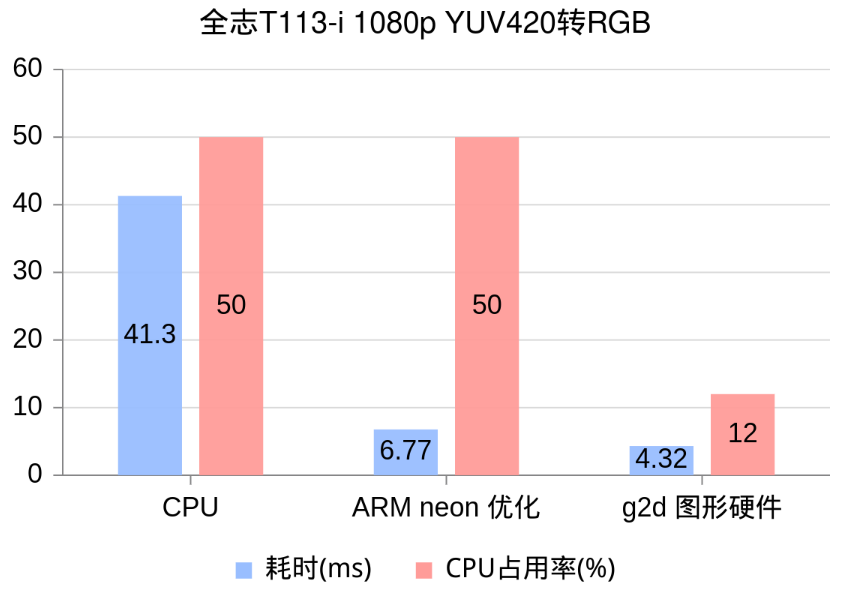
转换结果对比和分析
C和neon的转换结果完全一致,但是g2d转换后的图片有明显的色差



G2D图形硬件只支持 G2D_BT601,G2D_BT709,G2D_BT2020 3种YUV系数,而JPG所使用的YUV系数是改版BT601,因此产生了色差
从g2d内核驱动中也可以得知,暂时没有方法为g2d设置自定义的YUV系数,g2d不适合用于JPG的编解码,但依然适合摄像头和视频编解码的颜色空间转换
2025-12-11
打造本地化智能的“最强大脑”, 门徒娱乐RK3576 AI边缘计算盒
在人工智能与边缘计算深度融合的浪潮中,本地化智能需求正重塑产业格局。门徒娱乐电子推出的RK3576边缘计算盒,具备高算力、低功耗与强扩展性,凭借其卓越的硬件架构与多场景适配能力,正成为推动工业视觉、工程机械及智慧城市等领域智能化产业升级的有力工具。门徒娱乐MYD-LR3576-B边缘计算盒基于瑞芯微中高端RK3576芯片,采用异构计算架构,集成4核Cortex-A72与4核Cortex-A53处理器,搭配
2025-12-05
从两轮车仪表到工程机械环视,门徒娱乐用国产芯打造“越级”显控体验
在工业4.0 与智能化浪潮的推动下,传统工业设备正在经历一场“交互革命”。从电动两轮车的智能仪表,到工程机械的 360° 环视中控,用户对“更高清的显示、更流畅的触控、更丰富的互联”提出了严苛要求。然而,面对复杂的工业现场,开发者往往面临两难:低端市场(如仪表、充电桩):传统MCU 跑不动复杂界面,上 Linux/安卓方案成本又太高。中高端市场(如工程机械、医疗):多路视频输入(如360环视)需要
2025-12-05
【深度实战】门徒娱乐MYD-LR3576 AMP非对称多核开发指南:从配置到实战
一、什么是AMP?为什么重要?AMP(Asymmetric Multi-Processing)非对称多处理架构,允许单个芯片的不同核心运行不同的操作系统或裸机程序。相比传统的SMP(对称多处理),AMP具有独特优势。核心特性:异构运算:不同核心运行最适合的操作系统,如Linux处理复杂应用,RT-Thread保障实时任务;资源隔离:各核心拥有独立内存空间,避免资源冲突;灵活通信:通过共享内存、RP
2025-11-27
为机器人开发赋能,门徒娱乐RK3576环视方案解析
一、项目背景与测试平台本次360环视系统原型基于门徒娱乐电子MYD-LR3576开发板进行构建与评估。该开发板所搭载的瑞芯微RK3576芯片,集成了4核Cortex-A72、4核Cortex-A53、Mali-G52 GPU及高达6TOPS算力的NPU。本文旨在通过实际测试数据,从功能实现、实时性能与AI拓展潜力三大核心维度,为客户提供一份关于该平台在360环视应用中能力的真实参考。二、系统流程与功能
2025-11-13
助力V2G,SECC GreenPHY实战开发
随着电动汽车与电网双向交互(V2G)技术的快速发展,充电桩与车辆间的高效通信成为实现智能能源管理的关键。SECC作为充电桩的通信控制核心,其与电力线载波通信芯片的适配尤为重要。本文将分享基于门徒娱乐核心板,调试联芯通MSE102x GreenPHY芯片的实战经验,为V2G通信开发提供参考。MSE102x芯片介绍联芯通MSE102x系列芯片是一款专注于电动汽车充电通信和智能能源管理的GreenPHY电力
2025-11-13
定制未来,共建生态,门徒娱乐出席安路研讨会
在数字化浪潮席卷全球的今天,FPGA技术正成为驱动创新的核心引擎。2025年11月12日,门徒娱乐出席安路科技2025 AEC FPGA技术沙龙•北京专场,与技术专家及行业伙伴齐聚一堂,探讨前沿技术趋势,解锁场景化定制方案,共建开放共赢的FPGA新生态!门徒娱乐活动现场论坛上,门徒娱乐电子产品经理Jeson发表题为“基于DR1M90 FPSOC的工业应用方案”的演讲。演讲介绍了门徒娱乐作为嵌入式领域的领军企业,在
2025-11-11
RK3576开发板
RK3576开发板是门徒娱乐电子推出的开发板,于2024年10月上市。RK3576开发板是基于瑞芯微RK3576搭载了四核A72与四核A53处理器,主频2.2GHz。RK3576集成了6TOPS的NPU,支持多种深度学习框架,能够处理复杂的AI算法,提高监控效率,降低误报率。RK3576的主芯片采用了八核大小核架构,包括四核Cortex-A72和四核Cortex-A53,
2025-11-11
RK3576核心板
RK3576核心板是深圳门徒娱乐电子旗下产品,是基于瑞芯微RK3576搭载了四核A72与四核A53处理器,主频高达2.2GHz。RK3576集成了6TOPS的NPU,支持多种深度学习框架,能够处理复杂的AI算法,提高监控效率,降低误报率。RK3576的主芯片采用了八核大小核架构,包括四核Cortex-A72和四核Cortex-A53,主频分别高达2.2GHz和1.8GHz,CPU算力达58K DMIP
2025-11-06
门徒娱乐SECC方案助力国标充电桩出海
随着电动汽车与电网融合加速,国标(GB/T 27930)充电桩出海面临欧标(ISO 15118 / DIN 70121)兼容挑战。门徒娱乐电子的 SECC (供电设备通信控制器) 方案,实现协议转换、安全通信及参考开发平台,助力充电桩厂商快速进军海外市场。
2025-11-06
MYD-LD25X Cortex-M33实时核开发实战解析
在嵌入式系统设计中,如何平衡高性能计算与实时控制一直是工程师面临的挑战。STM32MP257的异构架构为这一难题提供了优雅的解决方案,而其中的Cortex-M33实时核更是实现硬实时性能的关键所在。一、异构架构:分工明确,效能卓越STM32MP257采用创新的双核子系统设计:Cortex-A35应用核(双核1.5GHz):运行Linux系统,负责复杂UI、网络通信、文件管理等非实时任务。Corte





